Friedrich Friesen | |
|---|---|
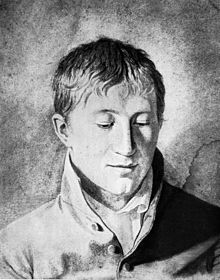 |
Karl Friedrich Friesen (25 September 1784 Magdeburg - 16 March 1814 La Lobbe, France) was a German gymnast and soldier, one of the principal promoters of gymnastics in Germany.
Friedrich Friesen | |
|---|---|
 |
Karl Friedrich Friesen (25 September 1784 Magdeburg - 16 March 1814 La Lobbe, France) was a German gymnast and soldier, one of the principal promoters of gymnastics in Germany.

He studied at the Academy of Architecture, Berlin, collaborated on the great atlas of Mexico edited by Humboldt, and from 1810 was an instructor in the Plamann Institute. In 1810-12 he rendered important services to Jahn in the establishment of German gymnastics.
Upon the outbreak of the German War of Liberation in 1813, he assisted in organizing the famous volunteer corps of Major von Lützow, whose adjutant he became. In mid-June 1813, the Lützow Freikorps was ambushed by Napoleonic troops near Kitzen due to a delay in an agreed troop withdrawal despite an armistice.
105 Lützowers fell, 90 were captured and 300 fled, including Lützow, Friesen and the seriously wounded Körner, who dragged himself to Großzschocher, about 11 km away. Various monuments in the region bear witness to these days.
After the dispersion of the corps by Napoleon at Rheims, he was captured and slain by French auxiliary troops from Lorraine near the village of La Lobbe, Ardennes on 15 March 1814. A long search for Friesen took place. In 1816, his friend August von Vietinghoff found the remains. In 1843, his remains were reburied in the Invalidenfriedhof in Berlin near the grave of Gerhard von Scharnhorst.
He has frequently been celebrated by German writers, in particular by E. M. Arndt in Es thront am Elbestrande.
An athletic multisport competition was named in honour of him. The first Friesenkampf was held in Germany 1928. [1] It consists of fencing, swimming, rifle shooting, running and shot put. In 2023, it was renamed to Klassischer Fünfkampf (in English: Classic Pentathlon). [2]
This article includes a list of references, related reading, or external links, but its sources remain unclear because it lacks inline citations .(July 2013) |

Frederick William III was King of Prussia from 16 November 1797 until his death in 1840. He was concurrently Elector of Brandenburg in the Holy Roman Empire until 6 August 1806, when the empire was dissolved.

Ludwig Adolf Wilhelm Freiherr von Lützow was a Prussian general notable for his organization and command of the Lützow Freikorps of volunteers during the Napoleonic Wars.

Friedrich Karl Ferdinand Freiherr von Müffling, nicknamed Weiss, was a Prussian Generalfeldmarschall and military theorist. He served as Blücher's liaison officer in Wellington's headquarters during the Battle of Waterloo and was one of the organizers of the final victory over Napoleon. After the wars he served a diplomatic role at the Congress of Aix-la-Chappelle and was a major contributor to the development of the Prussian General Staff as Chief. Müffling also specialized in military topography and cartography.

Lützow Free Corps was a volunteer force of the Prussian army during the Napoleonic Wars. It was named after its commander, Ludwig Adolf Wilhelm von Lützow. The Corpsmen were also widely known as the “Lützower Jäger“ or “Schwarze Jäger“, sometimes also "Lützower Reiter".

Leopold Hermann Ludwig von Boyen was a Prussian army officer who helped to reform the Prussian Army in the early 19th century. He also served as minister of war of Prussia in the period 1810–1813 and again from 1 March 1841 – 6 October 1847.

Karl Wilhelm Georg von Grolman(n) (30 July 1777 – 1 June 1843) was a Prussian general who fought in the Napoleonic Wars.
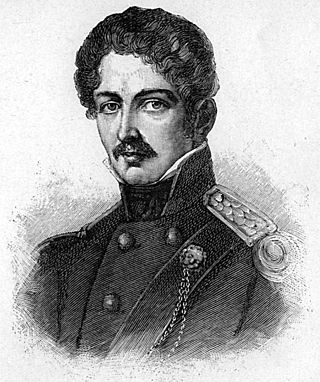
Carl Theodor Körner was a German poet and soldier. After having lived for some time in Vienna, where he wrote some light comedies and other works for the Burgtheater, he became a soldier and joined the Lützow Free Corps in the German uprising against Napoleon. During this time, he displayed personal courage in many fights, and inspired his comrades by fiery patriotic lyrics he composed. One of these was the "Schwertlied", composed during a lull in fighting, only a few hours before his death, and "Lützow's wilde Jagd", each set to music by both Carl Maria von Weber and Franz Schubert. He was often called the "German Tyrtaeus".

The first Wartburg Festival was a convention of about 500 Protestant German students, held on 18 October 1817 at the Wartburg castle near Eisenach in Thuringia. The former refuge of reformer Martin Luther was considered a national symbol and the assembly a protest against reactionary politics and Kleinstaaterei.

The Invalids' Cemetery is one of the oldest cemeteries in Berlin. It was the traditional resting place of the Prussian Army, and is regarded as particularly important as a memorial to the German Wars of Liberation of 1813–15.
The Battle of the Göhrde took place during the War of the Sixth Coalition on 16 September 1813 between French and Coalition troops at Göhrde, Germany. The French troops were defeated and withdrew to Hamburg.

The Royal Prussian Army was the principal armed force of the Kingdom of Prussia during its participation in the Napoleonic Wars.
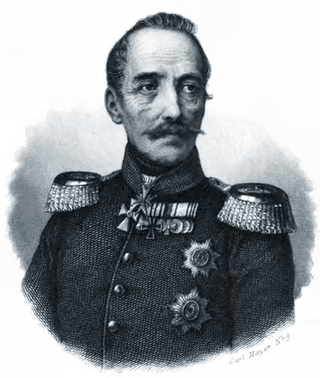
Karl Friedrich Emil zu Dohna-Schlobitten was a Prussian field marshal.

Friedrich (Fritz) Bury was Court painter to the royal courts of Kassel and Brussels, a German painter born in Hanau. He studied first under his father Jean Jacques Bury, who was a goldsmith and professor in the Academy of Design in Hanau, and with Anton Wilhelm Tischbein. In 1780 he visited for two years the Kunstakademie Düsseldorf, where he met Johann Heinrich Lips, with whom he returned to Hanau at the age of 19 and two month later they traveled to Rome. From November 1782 to July 1785 he lived with a nephew of Tischbein, Johann Heinrich Wilhelm Tischbein, Johann Georg Schütz and Lips in a rear building of the Palazzo Piombino in Via del Babuino 51. Later they followed their landlord to Via del Corso no. 18, now known as the Casa di Goethe, as Johann Wolfgang von Goethe also lived and worked there for over a year.
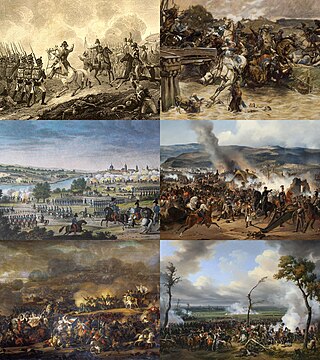
The German campaign was fought in 1813. Members of the Sixth Coalition, including the German states of Austria and Prussia, plus Russia and Sweden, fought a series of battles in Germany against the French Emperor Napoleon, his marshals, and the armies of the Confederation of the Rhine – an alliance of most of the other German states –, which ended the domination of the First French Empire.
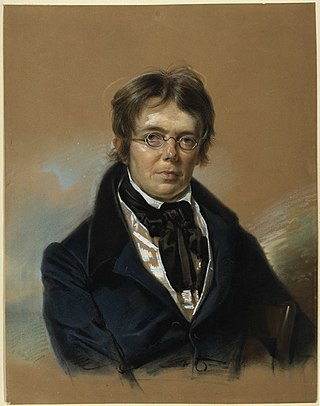
Christian Peter Wilhelm Friedrich Beuth was a Prussian statesman, involved in the Prussian reforms and the main mover in Prussia's industrial renewal.

"Schwertlied" is a poem by Theodor Körner, written shortly before his death in battle on 26 August 1813.
The Treaty of Paris of 24 February 1812 between Napoleon I of France and Frederick William III of Prussia established a Franco-Prussian alliance directed against Russia. On 24 June, Prussia joined the French invasion of Russia. The unpopular alliance broke down when the Prussian contingent in French service signed a separate armistice, the Convention of Tauroggen, with Russia on 30 December 1812. On 17 March 1813, Frederick William declared war on France and issued his famous proclamation "To My People".

Elisa Davidia Margarethe Countess of Ahlefeldt was a German-Danish noblewoman and wife of the Prussian General-major and war hero Adolf von Lützow (1782–1834).

Hutten's Grave (1823) is an oil on canvas painting by Caspar David Friedrich, showing a man in Lützow Free Corps uniform standing by the grave of the Renaissance humanist and German nationalist Ulrich von Hutten. Influenced heavily by the political climate of the time and Friedrich's own political beliefs, the painting is one of Friedrich's most political works and affirms his allegiance to the German nationalist movement. The painting was made to commemorate the 300th anniversary of Hutten's death and the 10th anniversary of Napoleon's invasion of Germany. It is now in the Klassik Stiftung Weimar's collection and on show in the Schlossmuseum at the Stadtschloss Weimar.

Classic Pentathlon, formally known as Friesenkampf, is an athletic multisport competition with a history that goes back to 1928. It consists of fencing, swimming, air rifle shooting, running and shot put. Classic Pentathlon is almost exclusively practiced by fencers and Modern pentathletes in Germany.